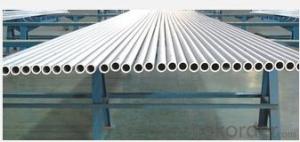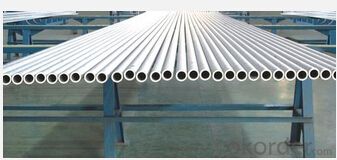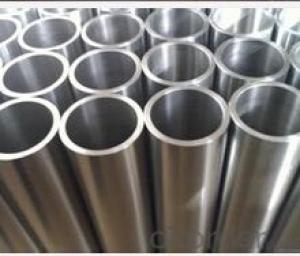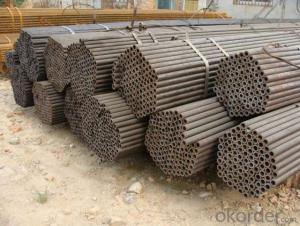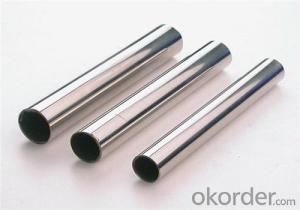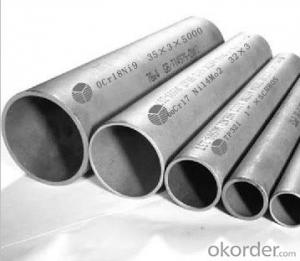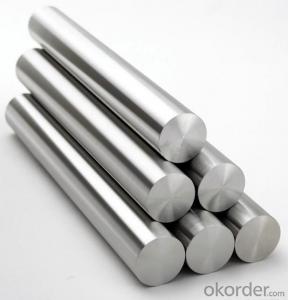seamless stainless boiler tubes
- Loading Port:
- China Main Port
- Payment Terms:
- TT OR LC
- Min Order Qty:
- -
- Supply Capability:
- -
OKorder Service Pledge
OKorder Financial Service
You Might Also Like
Specifications
seamless boiler tubesMaterial:304L,316L,316Ti,321,317L,310S,347H,904Letc.
Standard: A269, A213,
Cert:ISO
seamless boiler tubes
Material: 304L,316L,316Ti,321,317L,310S,347H,904L, 321 stainless steel welded pipe etc.
Standar duplex steel d: A269, A213, A312 201 stainless steel round tube
1. Material | TP304/304L, 316/316L, 310S, 317L, 321, 347H,etc. |
S31803, 32750, etc. | |
2. Sandard | ASTM, ASME, DIN, EN, ISO,JIS, GOST, etc. |
3. Type | Seamless |
4. Size rangetube | OD: from 6mm to 1000mm (NPS from 1/8'' to 40'') |
WT: from 0.7mm to 38mm (Schedule from 5S to XXS) | |
Length: fix length or un-fix length, Max 30meters | |
5. Produce process | Pilgering and cold drawn |
6. Surface process | Pickling and annealing |
AP tube | |
BA tube | |
7. Marking | JW, GRADE, seamless, STANDARD, SIZE, HT NO. |
8. Package | Bundles with waterproof cloth outside. |
or plywood box. | |
9. Min order quantity | 500 KG |
10. Sample | Yes |
11. OEM accepted | Yes |
12. Production capacity | 300 tons per month |
13. Payment term | T/T or L/C. |
14. Certificate | ISO 9001, PED |
15. Third party ertificate | BV, LR, SGS, TUV, CCS, ABS, etc. |
- Q: Can stainless steel pipes be used for gas supply?
- Indeed, gas supply systems can utilize stainless steel pipes. With its exceptional durability and resistance to corrosion, stainless steel proves to be an ideal material for a wide range of applications, including gas supply. Its capability to withstand high pressures and temperatures guarantees the secure and efficient conveyance of gas. Moreover, stainless steel pipes boast an extended lifespan and demand minimal maintenance, making them a dependable option for gas supply infrastructure. Nonetheless, it is crucial to ensure that the stainless steel pipes are meticulously designed, installed, and compliant with industry standards to uphold the safety and integrity of the gas supply system.
- Q: What is the difference between 316 and 316LN stainless steel pipes?
- 316 and 316LN stainless steel pipes are variations of the same stainless steel grade known as 316, but there are some distinctions between them. The primary disparity between 316 and 316LN stainless steel pipes resides in their nitrogen levels. 316LN stainless steel contains a higher nitrogen content than 316 stainless steel. The inclusion of nitrogen enhances the material's strength and corrosion resistance, making it more suitable for specific applications. Due to its elevated nitrogen content, 316LN stainless steel pipes display superior resistance to pitting and crevice corrosion, especially in chloride environments. This renders them particularly appropriate for utilization in marine settings or other scenarios where the pipes may encounter corrosive substances. Another contrast between the two grades lies in their availability and cost. 316 stainless steel pipes are more widely accessible and commonly employed, making them generally more cost-effective than 316LN stainless steel pipes. However, 316LN stainless steel pipes may be necessary for particular applications where enhanced corrosion resistance is required. In conclusion, the main difference between 316 and 316LN stainless steel pipes is their nitrogen content, which impacts their corrosion resistance properties. While 316 stainless steel is more readily available and cost-effective, 316LN stainless steel offers improved resistance to pitting and crevice corrosion, making it suitable for specific applications.
- Q: What does "stainless steel pipe 201304" mean?
- 201 stainless steel has a certain acid, alkali resistance, high density, polishing, no bubbles, no pinhole and other features, is the production of various watchcase, strap, cover, high-quality materials. Mainly used for decorative pipes, industrial pipes, and some shallow stretch products. The product belongs to high manganese, low nickel stainless steel, nickel content is low, poor corrosion resistance, in all kinds of desktop, countertops, kitchenware, and outdoor decoration projects and urban decoration industry and high-end household products, a larger amount.
- Q: Can stainless steel pipes be used for drinking water systems?
- Yes, stainless steel pipes can be used for drinking water systems. Stainless steel is a safe and hygienic material that is resistant to corrosion, rust, and scaling. It does not release harmful substances into the water and is approved by regulatory bodies for use in drinking water applications.
- Q: What is the difference between ERW and EFW stainless steel pipes?
- ERW (Electric Resistance Welded) stainless steel pipes are manufactured by rolling a flat steel into a cylindrical shape and then welding the edges together using electric resistance heat. On the other hand, EFW (Electric Fusion Welded) stainless steel pipes are produced by melting the edges of two steel plates or strips and then welding them together using an electric current. The main difference between ERW and EFW stainless steel pipes lies in the welding process, with ERW pipes having a smoother internal surface due to the absence of filler material, while EFW pipes have a slightly thicker weld seam. Additionally, EFW pipes are generally used for larger diameters and thicker walls, whereas ERW pipes are commonly used for smaller diameters and thinner walls.
- Q: What are the different sizes available for stainless steel pipes?
- Various industrial and residential applications can be catered to with a wide range of sizes of stainless steel pipes. The sizes of stainless steel pipes typically depend on their nominal pipe size (NPS) or outside diameter (OD). The diameter of stainless steel pipes commonly ranges from 1/8 inch to 48 inches. For smaller applications or plumbing systems, stainless steel pipes with NPS 1/8, 1/4, 3/8, and 1/2 are commonly utilized. These sizes are suitable for household plumbing, water supply lines, and low-pressure applications. As the requirements increase, larger stainless steel pipe sizes are available. Sizes such as NPS 3/4, 1, 1 1/4, 1 1/2, and 2 inches are commonly employed in various industries and commercial applications. These sizes are appropriate for higher-pressure applications like hydraulic systems, oil and gas pipelines, and chemical processing plants. For industrial applications that demand even larger pipes, stainless steel pipes with sizes ranging from 2 1/2 inches to 48 inches in diameter are accessible. These large pipes are frequently used in heavy-duty applications such as petrochemical plants, power generation facilities, and large-scale construction projects. It's important to note that stainless steel pipes are also obtainable in different wall thicknesses, known as schedules. The schedule number determines the wall thickness, with higher numbers indicating thicker walls. The most common schedules for stainless steel pipes are Schedule 5, Schedule 10, Schedule 40, and Schedule 80. In conclusion, a wide range of sizes are available for stainless steel pipes, starting from 1/8 inch and going up to 48 inches in diameter. The appropriate size selection depends on the specific application and the required pressure and flow requirements.
- Q: Are stainless steel pipes suitable for beer brewing applications?
- Yes, stainless steel pipes are highly suitable for beer brewing applications. Stainless steel is corrosion-resistant, ensuring the purity and quality of the beer. It also has excellent heat resistance, making it suitable for various brewing processes such as boiling and fermentation. Additionally, stainless steel is easy to clean and maintain, ensuring hygienic conditions throughout the brewing process.
- Q: Can stainless steel pipes be used for nuclear waste storage?
- Indeed, nuclear waste storage can make use of stainless steel pipes. Due to its exceptional resistance to corrosion, stainless steel proves to be an optimal material for the containment and transportation of dangerous substances like nuclear waste. The durability, strength, and capability to endure extreme temperatures of stainless steel render it apt for the prolonged storage of radioactive waste. Furthermore, stainless steel remains non-reactive and prevents the release of harmful substances, thus assuring the preservation of the stored waste's integrity. Nonetheless, it remains crucial to verify that the stainless steel utilized adheres to the specific requirements and standards established for nuclear waste storage to guarantee utmost safety and confinement.
- Q: Are stainless steel pipes suitable for underground water supply?
- Yes, stainless steel pipes are suitable for underground water supply. Stainless steel is highly resistant to corrosion and rust, making it an ideal material for underground applications where pipes may be exposed to moisture, soil, and other corrosive elements. Stainless steel pipes are durable, long-lasting, and have a high tensile strength, which makes them able to withstand the pressure and stress of underground installations. Additionally, stainless steel pipes are hygienic and do not leach harmful chemicals or contaminants into the water supply. Overall, stainless steel pipes are a reliable and safe option for underground water supply systems.
- Q: Are stainless steel pipes resistant to caustic environments?
- Yes, stainless steel pipes are highly resistant to caustic environments. Stainless steel is known for its corrosion-resistant properties, which make it suitable for use in various harsh environments, including those that contain caustic substances. The high levels of chromium in stainless steel create a passive, protective layer on the surface of the pipes, preventing corrosion and maintaining the integrity of the material. This layer acts as a barrier, shielding the steel from the corrosive effects of caustic substances such as acids, alkalis, and other chemicals. Therefore, stainless steel pipes are an excellent choice for applications that involve exposure to caustic environments, providing durability, longevity, and reliability in such conditions.
Send your message to us
seamless stainless boiler tubes
- Loading Port:
- China Main Port
- Payment Terms:
- TT OR LC
- Min Order Qty:
- -
- Supply Capability:
- -
OKorder Service Pledge
OKorder Financial Service
Similar products
Hot products
Hot Searches
Related keywords
